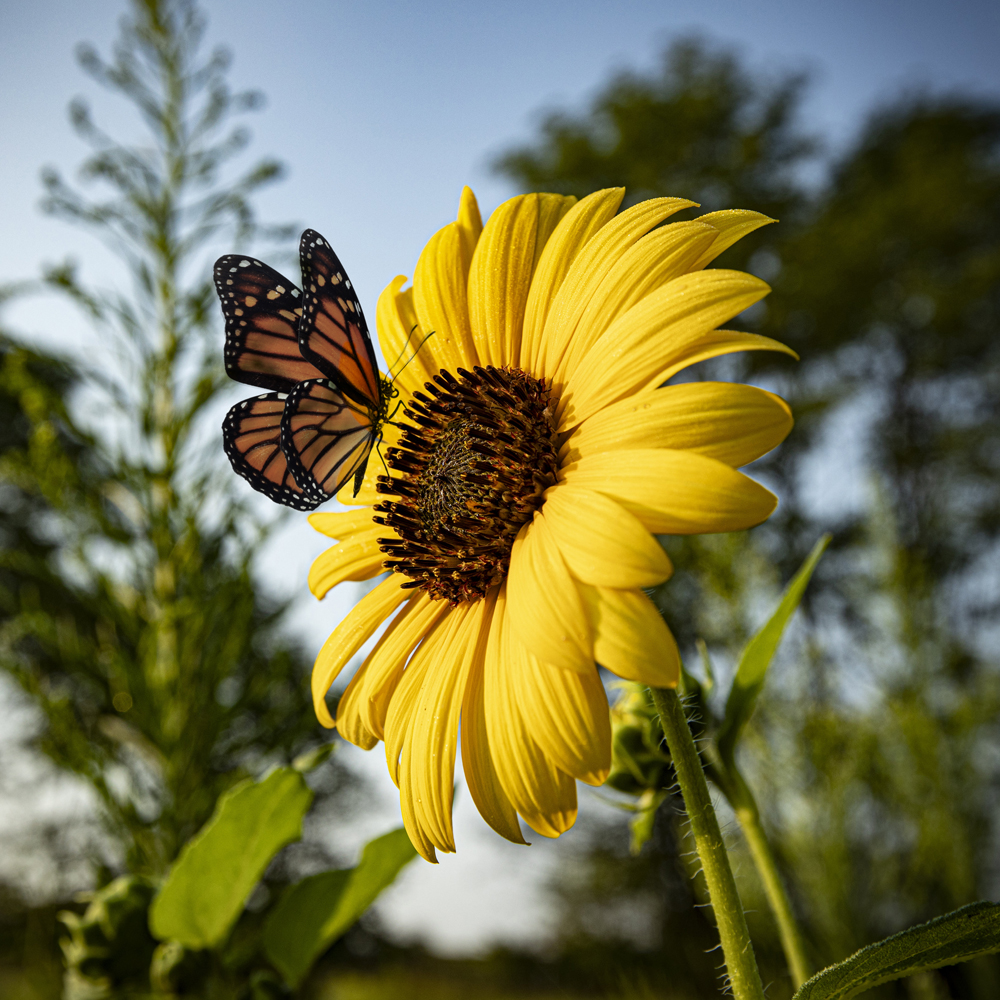The monarch is the only butterfly known to make a two-way migration. Monarchs from the eastern part of North America migrate to the Sierra Madre Mountains in Mexico, while those from west of the Rocky Mountain range overwinter in California. Some migration routes are as long as 3,000 miles. It can take as long as two months for a monarch to complete the journey south.
Seventeen Toyota sites across North America have planted pollinator gardens to nurture monarch butterflies and other pollinator species. All 17 gardens are along the monarch migration path. The gardens provide food and shelter to the butterflies at various stages of their life cycle as they make their way south for the winter, then return in the spring.
Toyota sites along the monarch's migration path:
- Princeton, Indiana vehicle assembly plant
- Georgetown, Kentucky vehicle assembly plant
- Blue Springs, Mississippi vehicle assembly plant
- San Antonio, Texas vehicle assembly plant
- Cambridge, Ontario vehicle assembly plant
- Woodstock, Ontario vehicle assembly plant
- Huntsville, Alabama powertrain plant
- Buffalo, West Virginia powertrain plant
- Troy, Missouri aluminum casting plant
- Jackson, Tennessee aluminum casting plant
- Delta, British Columbia aluminum casting plant
- Boston, Massachusetts parts distribution center
- York Township, Michigan Supplier Center
- Ann Arbor, Michigan R&D center
- Georgetown, Kentucky Production & Engineering Manufacturing Center
- Plano, Texas TMNA headquarters campus
- Toronto, Ontario Toyota Canada head office
When factoring in other automakers and suppliers across North America, the number of sites with pollinator gardens increases to nearly 200, thanks to the Pollinator Project Challenge issued by the Biodiversity Work Group – co-chaired by Toyota Motor North America – of the Suppliers Partnership for the Environment. For more information on this challenge, see "Expanding Our Reach."
Toyota & the Monarch Migration
Toyota is helping monarch butterflies by offering these colorful commuters several pollinator "pit stops" on their trip south in the Fall and north in the Spring.
PROTECTING SPECIES
Wildlife Habitat Council® (WHC) partners with corporations, fellow conservation organizations, government agencies and community members to empower and recognize meaningful wildlife habitat and conservation education programs. WHC‘s voluntary certification standard, Conservation Certification, is designed for broad-based biodiversity enhancement and conservation education activities on corporate landholdings.
Our partnership with WHC began in 1999 when Toyota joined WHC‘s membership. In 2008, the nature trail and environmental education programs at our Kentucky assembly plant became Toyota‘s first WHC certification. Today, programs at 13 Toyota sites have achieved Conservation Certifications.
INDICATOR SPECIES PROJECT
WHC helps us evaluate animal species on our sites and identify appropriate habitat development projects. Our protected areas include grassland, wildflower meadows, pollinator gardens and forests. Historically, we have focused our species protection efforts on birds such as tree swallows, red-tailed hawks and wood ducks, and on pollinators, namely monarch butterflies, bees and bats.
In 2019, we decided to expand our focus to indicator species. An indicator species serves as a measure of the environmental conditions in a given location. The presence of an indicator species can signal either a healthy ecosystem or an unhealthy one. Indicators can reveal information about various factors, including pollution levels and nutrient or food availability.
Toyota partnered with WHC to develop a tool to help us select indicator species appropriate for individual locations. The selection tool provides evaluation criteria, such as conservation status, food sources and technical expertise required to develop and maintain habitat. The tool is available to sites with programs already certified by WHC as well as those interested in future Conservation Certification.
Sites that have selected their species are now developing roadmaps to define habitat planning and construction. All sites are scheduled to have at least one activity started by 2021 and completion of their habitats by 2030. Once the habitats are developed, each site will monitor and track its indicator species impact.
Thirteen sites have selected an indicator species. The selection process at the remaining sites has been delayed due to the COVID-19 pandemic.
Species Protection
| Toyota Site | Indicator Species |
|---|---|
| Aluminum casting plant in Troy, Missouri | Grey Treefrog |
| Aluminum casting plant in Jackson, Tennessee | Tri-colored Bat |
| Powertrain plant in Huntsville, Alabama | Green Heron |
| Powertrain plant in Buffalo, West Virginia | Eastern Bluebird |
| Autobody parts plant in Long Beach, California | Anna Hummingbird |
| Assembly plant in Princeton, Indiana | Big Brown Bat |
| Assembly plant in Georgetown, Kentucky | Great Blue Heron |
| Assembly plant in Blue Springs, Mississippi | Wood Duck |
| Assembly plant in San Antonio, Texas | Loggerhead Shrike |
| Assembly plants in Cambridge and Woodstock, Ontario (Canada) | Tree Swallow |
| Assembly plant in Tijuana, Baja California (Mexico) | Red-tailed Hawk |
| Assembly plant in Apaseo el Grande, Guanajuato (Mexico) | Crested Caracara |
See "Endangered & Protected Species" in Performance.
CONSERVING HABITATS
Extreme weather events have been grabbing headlines with increasing frequency. Whether a hurricane, tornado or flood, communities face the challenge of recovering from the damage and preparing for potential repeats. Nonprofit organizations are taking a larger role in helping communities rebound, and restoring their access and enjoyment of local public lands is an important component. To support these efforts, the National Environmental Education Foundation (NEEF), with sole funding support from Toyota Motor North America, awarded $275,000 in grants to organizations in the U.S. and Puerto Rico. See "National Environmental Education Foundation" in Outreach for information on these grants as well as our other projects with NEEF to protect and restore public lands.
See "Protected Areas/ Critical Habitat" in Performance.
EXPANDING OUR REACH
TMNA is a member of Suppliers Partnership for the Environment (SP), an innovative partnership between automobile original equipment manufacturers, their suppliers and U.S. EPA. SP provides a forum for small, mid-sized and large automotive manufacturers and suppliers to work together, learn from each other and share environmental best practices. Kevin Butt, senior director of Environmental Sustainability at TMNA, is currently serving as SP Chair.
SP members share a common vision of working together to improve environmental sustainability and competitiveness of the global automotive supply chain. While environmental sustainability encompasses many important issues, advancing biodiversity conservation is one component of this vision and the focus of SP’s Biodiversity Work Group.
In 2019, SP Biodiversity Work Group co-chairs Kevin Butt and Sam Qureshi (Waste Management Sustainability Services) issued the SP Pollinator Project Challenge to member companies, asking them to make a commitment to implement or expand a pollinator project at one or more sites. Corporate conservation projects are individually meaningful, but they have the potential to be collectively groundbreaking.
"As automakers and suppliers come together to promote voluntary conservation programs across our respective lands, we have a unique opportunity to create a connected corridor of wildlife habitat spanning our individual operations and provide meaningful new habitat for pollinators and other migratory species, particularly considering the position and scale of our industry's manufacturing footprint in North America," explained Kevin Butt.
A variety of large and small SP member companies accepted the challenge, including DENSO International America, ES Group, ERA Environmental Management Solutions, FCA, FIC America Corp, Ford Motor Company, GHD, General Motors, Heritage Interactive Services, Honda of America Manufacturing, Lear Corp, Mobile Fluid Recovery, MPS Group, Robert Bosch LLC, Sustainable Materials Solutions LLC, Tetra Tech, Toyota Motor North America and Waste Management.
Through a memorandum of understanding with Wildlife Habitat Council (WHC), participating SP members received access to complimentary conservation resources to help guide them through a pollinator project design and implementation process, along with one-on-one technical support from WHC conservation specialists where needed. SP also engaged with the Pollinator Partnership to provide its members with additional educational resources and ideas to support pollinator conservation on their sites and within their communities.
Experts at WHC and ERA Environmental Management Solutions collected data and found that participating SP member companies are collectively managing nearly 200 pollinator projects across their respective sites, including both pollinator habitat projects and pollinator-focused employee and community education programs. Taken together, those projects represent over 2,400 acres of corporate lands that are currently being managed by SP member companies as wildlife habitat for pollinators.
"We look forward to building on our successes and lessons learned over this past year to further support current SP members, and other stakeholders along the automotive supply chain, in designing and implementing corporate conservation projects that can create meaningful new habitat for migratory species of concern in North America like the monarch butterfly," said Sam Qureshi, national business development manager, Waste Management Sustainability Services.

